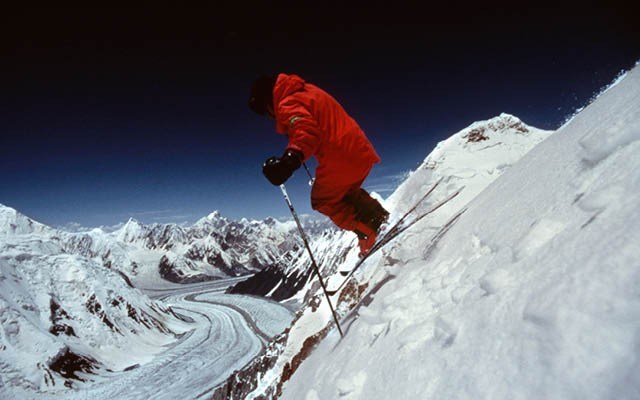The skier in the film is mesmerizingly kinetic. Flying down the hill, hair swinging, eyes riveted on the next turn, he hops with authority, a dynamic interplay of pumping legs and stabbing poles. Despite the erratic energy, there are only occasional lurches over the precipice of balance, making it all appear far smoother than you would imagine. Smoother, because the man is actually skiing on rocks — not sand or gravel or some other granular medium approximating snow, but the large, irregular rocks of a talus slope, one of which, the size of a dog, dislodges at one point to whiz past him. It's impressive, but also seems insane —. even impossible — if he weren't pulling it off in front of your eyes. And therein lies the moxie, skill and mystique behind Le Skieur de l'Impossible, Sylvain Saudan.
Saudan — also known as The Father of Extreme Skiing — famously ripped snowless slopes as a training exercise (one time skiing Japan's Mt. Fuji sans niege), averring that if one could ski on rocks one could handle any snow condition. It clearly worked for the physically compact Swiss guide, who forged a reputation for skiing slopes and conditions that no one at the time would have considered. But thinking what might be possible differs markedly from knowing, and so Saudan set out to collect that knowledge.
Beginning with his 1968 descent of the 55-degree Spencer Couloir in Chamonix, Saudan went on a global tear that saw him bag, among other first descents, Chamonix's Whymper and Gervasutti Couloirs, the fearsome Marinelli Couloir off Monte Rosa, the southwest face of Mont Blanc, northwest face of the Eiger, southwest face of Denali from its 6,068-metre summit, and Pakistan's Hidden Peak, a nine-hour descent following a 35-day climb that landed him in the Guinness Book of World Records — for the third time — as the first to ski off an 8,000-metre peak. A coterie of contemporary French "extremists" quickly took up the fall-you-die mantle — notably Patrik Vallençant, Anselme Baud, Jean-Marc Boivin and Bruno Gouvy — but it was Saudan's name and windshield-washer jump turn that would become synonymous with extreme skiing, an enterprise that led directly to today's freeskiing milieu. No surprise that these accomplishments were honoured in the naming of Blackcomb Mountain's original test piece, Saudan Couloir.
In the 1980s, Saudan's name carried the fearsome reputation Blackcomb desired. He would have been happy about the nod — were his permission sought. Instead, he'd learned of its use through the infamous race that took place annually on the run. Disgruntled that a raft of corporate sponsors were leveraging his name for commercial exposure, Saudan sued, eventually settling out of court. In the meantime, the run was renamed Couloir Extreme on trail maps — though everyone in Whistler still calls it The Saudan.
This mucky slice of ski history might have been avoided had Blackcomb's management of the day reached out to Saudan prior to his first visit here in 1989, when he was invited by the irrepressible filmmaker Peter Chrzanowski to ski Mt.. Waddington with Eric Pehota for the film Reel Radical. Chrzanowski's extreme-skiing exploits had, in part, been inspired by Saudan, and the two became friends during the Mt. Waddington shoot. Now, 28 years after his first visit, Chrzanowski will again host the now 80-year-old Saudan in Whistler during the World Ski and Snowboard Festival. On Saturday, April 8 at Millennium Place, Saudan will show a short film followed by a rarely seen 54-minute documentary from his 1972 epic first descent of Denali. He'll also answer questions about the films and steep skiing — something he has done thousands of times as an inspirational speaker. Shows are at 7 p.m. and 9 p.m., and tickets are $18.
It's an opportunity to see one of skiing's true pioneers. In this season's smash ski-film hit La Liste, Swiss ski-mountaineering phenom Jérémie Heitz challenges himself to ski 15 of the Alps' steepest 4,000-metre peaks in just two ski seasons. Heitz's high-speed, big-turn approach to these descents is a new frontier in freeriding, but he still credits Saudan — who appears in the film — as the father of the genre.
Britain's Daily Mail once called Saudan "a kind of Evel Knievel of the Alps," a sensationalistic and wrong-headed appellation. "I'm no daredevil," Saudan said back in 1972, during the heyday of his ascendency. "I don't want to risk my life, I wish to control the risk to go beyond the known limits. It's a sport to me."
As befitted the flowery gestalt of the times, writer Dave Youmans tried to plumb this psychology sentiment in a 1971 profile of Saudan in Skier's Gazette.
"Perhaps the most persuasive reason why he does it is existential. On each turn — turn after turn continuously for 6,000 feet — he takes his life into his own hands. Life and consciousness intensified to a white-hot moment. There is no past and no future. Only an obligatory present. Or all three succeeding on another in a cyclical, harmonic continuum. Past, present, future — life, death and rebirth. Each turn a renewal of his tenuous and accidental place on the mountain."
Leslie Anthony is a Whistler-based author, editor, biologist and bon vivant who has never met a mountain he didn't like.




